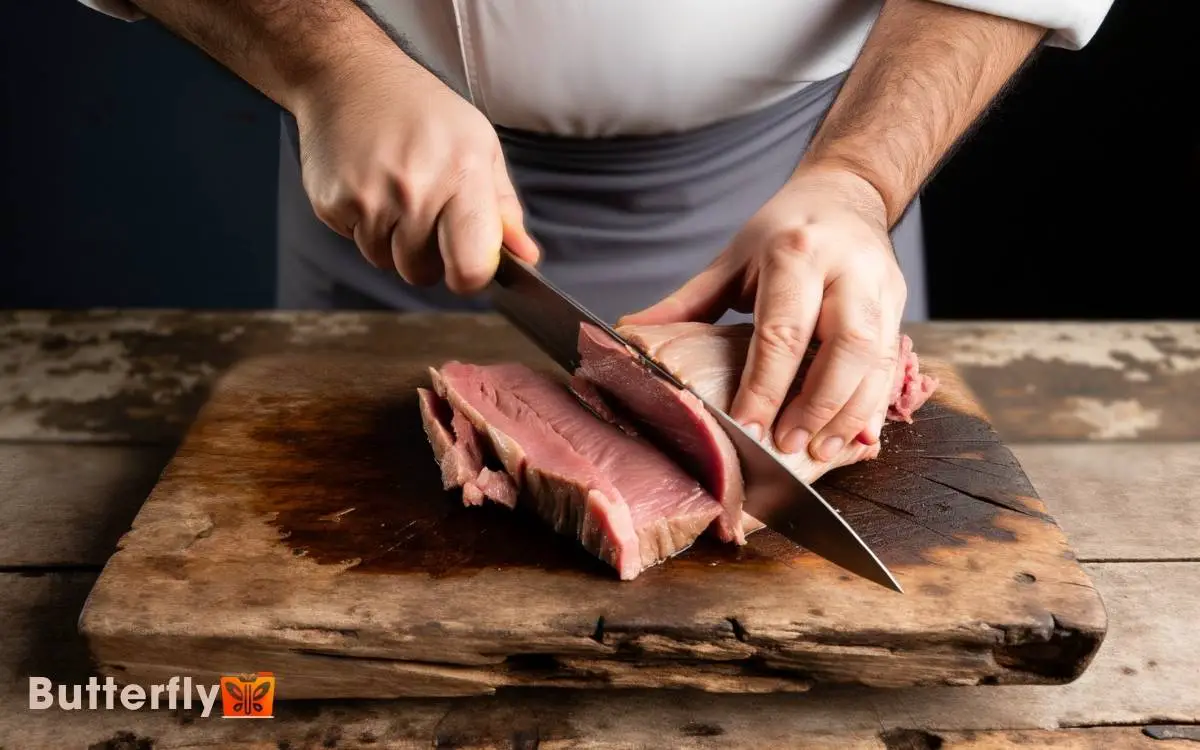How To Butterfly A Tenderloin? Step-by-Step Guide!
To butterfly a tenderloin, start by trimming excess fat with kitchen shears. Place it on a stable cutting board, thicker end facing you.
Using a sharp chef’s knife, make a horizontal cut along the tenderloin, stopping about an inch from the edge.
Open it like a book to guarantee uniform thickness. Then, cover it with plastic wrap and gently pound from the center outward using a meat mallet or rolling pin, achieving even thickness and preventing tearing.
Inspect and adjust as needed for a smooth, flat piece. For further details on seasoning and stuffing, follow along to enhance your dish.

Key Takeaways
Gather Your Tools
To start, make sure you have a sharp chef’s knife, a clean cutting board, and a pair of kitchen shears at the ready.
A sharp knife guarantees clean cuts, reducing the risk of tearing the tenderloin. The cutting board should be sturdy and spacious, giving you ample room to maneuver.
Kitchen shears will help trim any excess fat or sinew, guaranteeing a clean presentation.
Additionally, consider having a digital kitchen scale on hand for precise measurements, particularly useful if you’re aiming for consistency in portion sizes. A damp cloth nearby will keep your workspace tidy and slip-free.
Gathering these tools guarantees you’re well-prepared to butterfly the tenderloin with precision and efficiency, setting the stage for innovative culinary techniques.
Prepare the Tenderloin
- Begin by trimming any excess fat from the tenderloin to guarantee an even cut.
- Next, position the tenderloin on a clean surface, aligning it to facilitate a straight, precise cut.
- Secure the tenderloin with one hand to maintain stability while you prepare to butterfly it.
Trim Excess Fat
Start by placing the tenderloin on a clean cutting board, making sure you have a sharp knife ready to trim away any excess fat.
Begin by identifying the silverskin, a tough, silvery membrane that doesn’t render during cooking. Insert the knife just under the silverskin, angling it upwards to avoid cutting into the meat. Use smooth, sweeping motions to remove it completely.
Next, inspect the tenderloin for any thicker, white fat deposits. Trim these away carefully, as they can cause uneven cooking. Rotate the tenderloin as needed to access all sides.
Position for Cutting
Align the tenderloin lengthwise on your cutting board, ensuring it’s stable and evenly positioned to make precise, controlled cuts. This alignment is essential for achieving a uniform butterfly.
Secure the tenderloin by gently pressing it down with your non-dominant hand. This provides stability and prevents slipping.
With a sharp knife, start at the thicker end and make a horizontal cut down the center, stopping just short of cutting all the way through. Carefully open the meat like a book. This technique, known as butterflying, helps the meat cook more evenly and absorb flavors better. To butterfly a Cornish game hen, press down firmly to flatten it after making the cut, ensuring even roasting. Once fully prepared, season generously and proceed with your preferred cooking method.
Rotate the tenderloin 180 degrees and repeat the process on the other side. Ensuring an even thickness throughout will promote consistent cooking and a professional presentation.
Your precision here sets the foundation for a beautifully butterflied tenderloin.
Make the Initial Cut
Position the tenderloin on a clean cutting board with the flat side down.
Using a sharp knife, make a precise cut down the center of the meat, stopping just before you cut all the way through.
Make sure your knife is steady to create an even, symmetrical opening.
Position the Tenderloin Properly
Make sure that the tenderloin is placed on a stable cutting board with the wider end facing you and the tapered end pointing away. This positioning guarantees excellent control and precision.
Align the tenderloin so it’s centered and lies flat. Use a sharp chef’s knife, which allows for cleaner, more accurate cuts.
Before making any cuts, inspect the tenderloin for any silverskin or excess fat that may need trimming. Remove these to create a smooth, even surface.
Maintaining a consistent angle with your knife will help achieve the uniformity necessary for a perfect butterfly.
Your aim is to create a symmetrical cut, which will facilitate even cooking and an enhanced presentation. Remember, precision at this stage sets the foundation for success.
Slice Down the Center
With your tenderloin properly positioned and trimmed, start by carefully slicing down the center lengthwise, stopping just short of cutting through to the other side. Use a sharp, long-bladed knife for precision. Maintain a steady hand, ensuring the cut is even and consistent from end to end.
By not cutting all the way through, you create a hinge that allows the meat to open like a book. This technique maximizes surface area for seasoning and even cooking. As you slice, apply gentle, controlled pressure to avoid tearing the meat.
Once the initial cut is made, you’ll be ready to proceed with further steps to achieve a perfectly butterflied tenderloin for your innovative culinary creations.
Open the Tenderloin
Begin by placing the tenderloin on a clean, stable cutting board, making sure the thicker end faces you. Using a sharp knife, carefully make a horizontal cut along the length of the tenderloin, stopping about an inch from the edge.
Open the tenderloin like a book, making sure it lies flat. Continue slicing horizontally if needed, maintaining the same depth, to achieve uniform thickness. You might need to adjust your cut slightly to guarantee the meat opens evenly. Take care not to cut all the way through.
Your goal is a symmetrical, flat piece of meat that will cook uniformly. Precision here sets the stage for a perfectly cooked tenderloin, ready for your innovative culinary techniques.
Flatten the Meat
Now that your tenderloin is opened and lying flat, place a sheet of plastic wrap over the meat to prepare for flattening.
Use a meat mallet or a rolling pin to gently pound the tenderloin, starting from the center and working your way outwards. This guarantees even thickness and uniform cooking. Take care not to tear the meat.
Here’s a quick reference table to guide you:
| Tool | Benefit |
|---|---|
| Meat Mallet | Provides precise control and even thickness |
| Rolling Pin | Spreads force evenly, less risk of tearing |
| Plastic Wrap | Prevents contamination and keeps workspace clean |
| Center-Out Technique | Ensures uniformity and prevents thin edges |
| Gentle Force | Maintains meat integrity while achieving flatness |
Following these steps will prepare your tenderloin perfectly for the next stage.
Season the Tenderloin
Seasoning the tenderloin meticulously guarantees that every bite is flavorful and delicious. Begin by patting the meat dry with paper towels to make sure the seasoning adheres well.
Generously sprinkle kosher salt and freshly ground black pepper over the entire surface. Enhance the flavor profile by applying a blend of aromatic herbs and spices.
- Herbs: Use fresh rosemary, thyme, and sage for a fragrant, savory touch.
- Spices: Incorporate garlic powder, paprika, and a hint of cayenne for depth and a slight kick.
- Oil: Lightly coat the tenderloin with olive oil to help the seasonings bind and to promote even cooking.
Rub the seasonings into the meat, ensuring an even distribution for maximum flavor.
Tips for Stuffing
With your seasoned tenderloin ready, it’s time to prepare it for stuffing to enhance its flavor and presentation further. Start by laying the butterflied tenderloin flat on a clean surface. Spread an even layer of your chosen stuffing, making sure it reaches all edges for consistent flavor.
Gently roll the tenderloin, keeping the stuffing secure inside. Use kitchen twine to tie the roll at intervals to maintain its shape during cooking.
| Ingredient | Quantity | Notes |
|---|---|---|
| Spinach | 2 cups | Fresh, sautéed |
| Feta Cheese | 1 cup | Crumbled |
| Sun-Dried Tomatoes | 1/2 cup | Chopped |
Carefully place the stuffed tenderloin on a baking sheet, seam side down. Ensure even cooking by preheating your oven to the recommended temperature.
Conclusion
You’ve mastered the art of butterflying a tenderloin. This technique not only enhances the tenderness but also allows you to infuse the meat with your favorite seasonings or stuffing.
Did you know that properly butterflied and seasoned tenderloin can retain up to 30% more moisture during cooking? This results in a juicier, more flavorful dish.
With these steps, you’re now equipped to elevate your culinary creations to new heights. Happy cooking!






